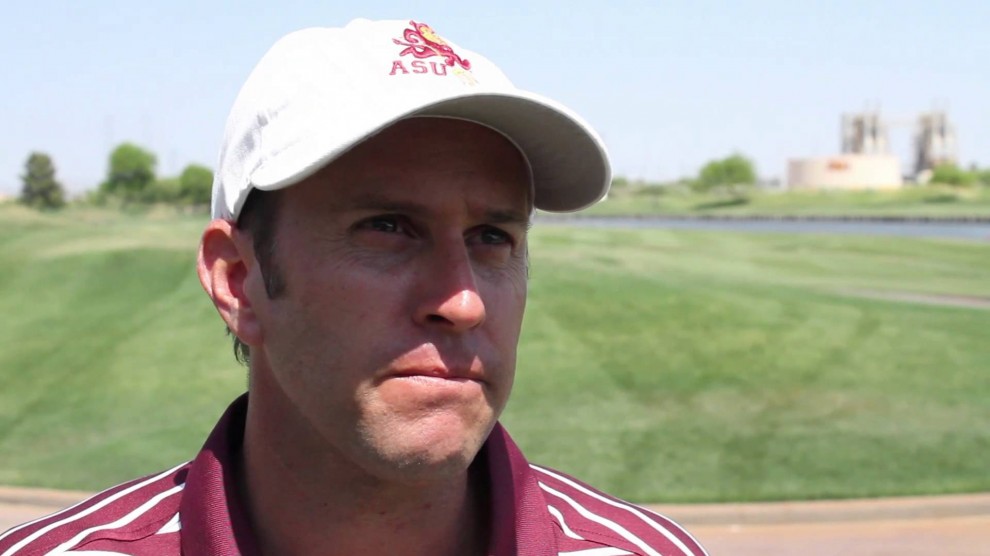As Arizona State prepares for its fall season opener at the Olympia Fields Invitational Sept. 18-20 in Chicago, head coach Tim Mickelson is optimistic.
He has good reason to be.
The Sun Devils welcome back their entire starting lineup from last year, including standout Jon Rahm who enters his senior season ranked No. 1 in the World Amateur Golf Rankings. Rahm, with seven career wins, collected the Ben Hogan Award as the top amateur golfer in the country last season. He also made the most of an exemption to this year’s Waste Management Phoenix Open, tying for fifth.
“We have very high expectations this year,” Mickelson said in a recent interview. “Our expectations are to be a top-five team again but to perform better at the national championship.”
ASU started out strong at last season’s national championship at the Concession Golf Club in Bradenton, Fla., but ultimately fell short missing the cut.
Mickelson – whose big brother is former Sun Devil, current PGA Tour star and sometimes “actor” Phil Mickelson – played collegiately at ASU and Oregon State and turned pro in 2000. After a year and a half, Mickelson took a break from golf before joining the coaching ranks taking over at the University of San Diego in 2003 where he led the Toreros to their first three NCAA appearances in program history. He remained with USD until 2011 when he accepted the Sun Devils job.
I caught up with Mickelson recently to chat about the upcoming season, the state of college golf, recruiting, and who claims family bragging rights when he and Phil tee it up.
JL: What have been some of your best moments at ASU?
TM: Last year as a whole was a dream year. We won five times in the spring, and got as high as #2 in the country in the spring.
JL: What’s the state of college golf right now?
TM: College golf is in a great spot. There are a decent amount of college players having immediate success at the pro level which validates that college golf is a very worthwhile endeavor.
JL: What can be done to widen the audience for college golf?
TM: That’s a good question. In every other sport you have people watching the pros of tomorrow, but very few people do this for the sport of golf.
JL: Beyond skill, what qualities and characteristics do you look for in the players you recruit?
TM: Confidence, leadership skills.
JL: Can you walk me through the recruiting process?
TM: It starts earlier than it should but nowadays we usually spot a recruit in the eighth or ninth grade, and then continue to watch and scout them over the next few years until we have the chance to get them on campus and talk to them in depth about what ASU has to offer.
JL: What’s the competition level like in the Pac-12?
TM: Highest level in college golf. Very, very high.
JL: What experiences from your own playing days did you take with you into coaching?
TM: The main thing I took with me is the memories of what it feels like to be nervous, stressed, overwhelmed, excited, while on the course competing. Some coaches have never felt this.
JL: As a player, what was your best round ever?
TM: I have shot 64 in competition three times that I can remember: twice at the Porter Cup and once in the 2000 Pac-10 Championship.
JL: What has been your biggest highlight, either playing or coaching?
TM: Biggest playing highlight would have been finishing second in the 2000 Pac-10 Championship, only losing to Paul Casey. My biggest as a coach would be winning five times last spring and having a ranking of #2 in the country for part of the spring.
JL: Who is filling out the final three spots in your dream foursome?
TM: Playing St. Andrews with Abraham Lincoln, Bobby Jones and my grandfather, Al Santos.
JL: Describe your coaching philosophy.
TM: I’m focused on having our guys get better on a daily basis. Little by little we want their foundation to be that of professional golfers.
JL: How often do you and Phil get to play together and how competitive are the rounds between you two?
TM: The rounds aren’t as competitive as they used to be because I don’t get to play as much, but they are still competitive. I used to beat him about 25 percent of the time but I think it’s down to about 12 percent now. We only get to play about four times a year together.

